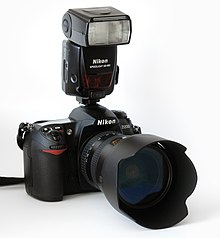Cultural artifact: Difference between revisions
No edit summary Tags: Mobile edit Mobile web edit |
→See also: and many other things |
||
| (46 intermediate revisions by 33 users not shown) | |||
| Line 1: | Line 1: | ||
{{short description|Social scientific term}} |
|||
| ⚫ | ''' |
||
{{Use American English|date=July 2020}} |
|||
{{Use dmy dates|date=July 2020}} |
|||
[[File:Nikon D200 front (aka).jpg|thumb|Nikon D200 Digital Camera]] |
|||
{{LibraryandInformation-TopicSidebar}} |
|||
| ⚫ | A '''cultural artifact''', or '''cultural artefact''' (see [[American and British English spelling differences#Miscellaneous spelling differences|American and British English spelling differences]]), is a term used in the [[social sciences]], particularly [[anthropology]],<ref>{{cite book| url = https://books.google.com/books?id=4SIXk2bp5u8C&q=The+pragmalinguistic+analysis+of+narrative+texts&pg=PP1 | title = The pragmalinguistic analysis of narrative texts | author = Richard J. Watts | isbn=978-3-87808-443-3 | year=1981 | publisher=Gunter Narr Verlag}}</ref> [[ethnology]]<ref>{{cite book| url = https://books.google.com/books?lr=&as_brr=0&q=warrabarna+kaurna!&btnG=Search+Books | title = Warrabarna Kaurna! | author = Rob Amery}}</ref> and [[sociology]]{{Citation needed|date=September 2009}} for anything created by [[human]]s which gives information about the [[culture]] of its creator and users. <!-- the article should be expanded, and this sentence would be a good start, but it just is not clear enough without rewriting or explanation. The artifact may change over time in what it represents, how it appears and how and why it is used as the culture changes over time.--> ''Artifact'' is the spelling in [[North American English]]; ''artefact'' is usually preferred elsewhere. |
||
| ⚫ | Cultural artifact is a more generic term and should be considered with two words of similar, but narrower, nuance: |
||
| ⚫ | Cultural artifact is a more generic term and should be considered with two words of similar, but narrower, nuance: it can include objects recovered from [[archaeological site]]s, i.e. [[Artifact (archaeology)|archaeological artifacts]], but can also include objects of modern or early-modern society, or '''social artifacts'''. For example, in an anthropological context: a 17th-century [[lathe]], a piece of [[faience]], or a [[television]] each provides a wealth of information about the time in which they were manufactured and used. |
||
Cultural artifacts, whether ancient or current, have a significance because they offer an insight into: technological processes, economic development and social structure, among other attributes. |
Cultural artifacts, whether ancient or current, have a significance because they offer an insight into: technological processes, economic development and social structure, among other attributes. |
||
==Classification== |
|||
The philosopher [[Marx W. Wartofsky]] categorised artifacts as follows:<ref>Wartofsky, Marx W. (1979). Models: Representation and scientific understanding. Dordrecht, The Netherlands: Reidel.</ref> |
The philosopher [[Marx W. Wartofsky]] categorised artifacts as follows:<ref>Wartofsky, Marx W. (1979). Models: Representation and scientific understanding. Dordrecht, The Netherlands: Reidel.</ref> |
||
* primary artifacts: used in production (such as a hammer, a fork, a lamp or a camera); |
* primary artifacts: used in production (such as a hammer, a fork, a lamp or a camera); |
||
* secondary artifacts: relating to primary artifacts (such as a user-manual for a camera); |
* secondary artifacts: relating to primary artifacts (such as a user-manual for a camera); |
||
* tertiary artifacts: representations of secondary artifacts (such as a |
* tertiary artifacts: representations of secondary artifacts (such as a picture of a user-manual for a camera). |
||
| ⚫ | |||
== See also == |
|||
| ⚫ | |||
* [[Art object]] |
|||
* [[Biofact (archaeology)|Biofact]] |
|||
* [[Mentifact]] |
|||
== References == |
== References == |
||
{{Reflist}} |
{{Reflist}} |
||
==Further reading== |
== Further reading == |
||
* Habib, Laurence, and Line Wittek (2007). The portfolio as artifact and actor. ''Mind, Culture and Activity'', Vol. 14, No. 4, ISSN |
* Habib, Laurence, and Line Wittek (2007). The portfolio as artifact and actor. ''Mind, Culture and Activity'', Vol. 14, No. 4, {{ISSN|1074-9039}}. |
||
==External links== |
== External links == |
||
* {{ |
* {{cite SEP |url-id=artifact |title=Artifact |last=Hilpinen |first=Risto}} |
||
{{Culture}} |
{{Culture}} |
||
| Line 31: | Line 32: | ||
{{DEFAULTSORT:Cultural Artifact}} |
{{DEFAULTSORT:Cultural Artifact}} |
||
[[Category: |
[[Category:Cultural anthropology]] |
||
[[Category:Museology]] |
[[Category:Museology]] |
||
[[Category:Cultural heritage |
[[Category:Cultural heritage]] |
||
[[Category: |
[[Category:Cultural concepts|Artifact]] |
||
Latest revision as of 01:47, 8 May 2024

| Part of a series on |
| Library and information science |
|---|
 |
A cultural artifact, or cultural artefact (see American and British English spelling differences), is a term used in the social sciences, particularly anthropology,[1] ethnology[2] and sociology[citation needed] for anything created by humans which gives information about the culture of its creator and users. Artifact is the spelling in North American English; artefact is usually preferred elsewhere.
Cultural artifact is a more generic term and should be considered with two words of similar, but narrower, nuance: it can include objects recovered from archaeological sites, i.e. archaeological artifacts, but can also include objects of modern or early-modern society, or social artifacts. For example, in an anthropological context: a 17th-century lathe, a piece of faience, or a television each provides a wealth of information about the time in which they were manufactured and used.
Cultural artifacts, whether ancient or current, have a significance because they offer an insight into: technological processes, economic development and social structure, among other attributes.
Classification
[edit]The philosopher Marx W. Wartofsky categorised artifacts as follows:[3]
- primary artifacts: used in production (such as a hammer, a fork, a lamp or a camera);
- secondary artifacts: relating to primary artifacts (such as a user-manual for a camera);
- tertiary artifacts: representations of secondary artifacts (such as a picture of a user-manual for a camera).
Social artifacts, unlike archaeological artifacts, do not need to have a physical form (for example virtual artifact), nor to be of historical value (items created seconds ago can be classified as social artifacts).
References
[edit]- ^ Richard J. Watts (1981). The pragmalinguistic analysis of narrative texts. Gunter Narr Verlag. ISBN 978-3-87808-443-3.
- ^ Rob Amery. Warrabarna Kaurna!.
- ^ Wartofsky, Marx W. (1979). Models: Representation and scientific understanding. Dordrecht, The Netherlands: Reidel.
Further reading
[edit]- Habib, Laurence, and Line Wittek (2007). The portfolio as artifact and actor. Mind, Culture and Activity, Vol. 14, No. 4, ISSN 1074-9039.
External links
[edit]- Hilpinen, Risto. "Artifact". In Zalta, Edward N. (ed.). Stanford Encyclopedia of Philosophy.
